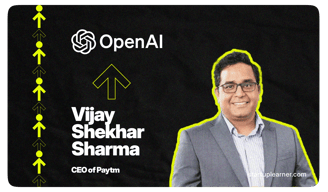Vijay Shekhar Sharma: How Paytm Redefined Money for a Billion Indians
FOUNDERS
Startup Learner
4/29/20252 min read



Introduction
When India’s demonetization crisis hit in 2016, one startup stood ready to serve a nation suddenly starved of cash: Paytm.
But the real story began much earlier, with Vijay Shekhar Sharma, a small-town boy who built one of India’s most iconic tech companies — battling language barriers, rejection, and financial struggles along the way.
His journey is a symbol of resilience, timing, and relentless ambition.
Early Life and Background
Born in 1978 in Aligarh, Uttar Pradesh, Vijay grew up in a humble middle-class family.
He studied in Hindi-medium government schools, where he faced major challenges when he entered Delhi College of Engineering (now DTU) — all classes were taught in English.
Struggling with language barriers and culture shock, Vijay didn’t give up.
Instead, he self-learned English, taught himself coding, and started building small tech projects.
By his second year of college, he had created a content management system (CMS) that he later sold for ₹2 lakh — his first entrepreneurial success.
This mix of technical skill and hustle would define his career.
The Big Idea: Making Money Move
After a few smaller ventures, Vijay founded One97 Communications in 2000 — providing mobile content services like ringtones, astrology updates, and cricket scores.
But in 2010, he made a bold pivot:
He saw the rise of smartphones and realized India needed a simple, mobile-first payments solution.
Thus, Paytm (Pay Through Mobile) was born — initially focusing on mobile recharges and utility bill payments.
Vijay's early bets:
Focus on mass adoption — keep transactions simple, fast, and trustable.
Build for Tier 2/3 cities — not just metros.
Empower small businesses to go digital.
For years, Paytm grew steadily — but the real explosion came in 2016.
Building the Company: The Demonetization Catalyst
In November 2016, India suddenly demonetized ₹500 and ₹1,000 currency notes.
Cash became scarce overnight.
Paytm, already trusted for recharges and bill payments, pivoted instantly:
Launched massive marketing campaigns ("Paytm Karo").
Enabled millions of small merchants to accept mobile payments without bank POS machines.
Expanded rapidly into payments bank, e-commerce, ticketing, insurance, and financial services.
By the end of 2016, Paytm had tripled its user base — from 125 million to over 350 million users.
Today, Paytm offers:
Wallets
UPI services
Lending and insurance
Ticket booking
Online shopping
Wealth management
Vijay built a true digital financial ecosystem.
Lessons for Founders
Vijay Shekhar Sharma’s story offers incredible lessons:
1. Turn weaknesses into strengths.
Struggling with English didn’t stop him — it made him more determined.
2. Bet before the wave hits.
He launched Paytm years before digital payments became mainstream.
3. Serve Bharat, not just India.
By focusing on small towns and local merchants, he tapped into massive underserved markets.
4. Move fast during crises.
Paytm’s rapid action during demonetization became a textbook case of opportunity spotting.
5. Keep evolving.
From mobile recharges to a full-stack fintech platform, Paytm never stood still.
The Impact
Paytm changed how Indians think about money.
It introduced digital wallets to daily life, empowered millions of small businesses, and helped accelerate financial inclusion across India.
Vijay also inspired a generation of entrepreneurs from non-urban backgrounds — showing that global-scale companies can rise from small towns.
Conclusion
Vijay Shekhar Sharma's story is a lesson in resilience, foresight, and seizing moments of change.
For aspiring founders, his journey says:
Don't wait for ideal conditions. Build now, prepare now — and when the world changes, you’ll be ready.
In the race to shape India’s digital economy, Vijay didn’t just participate — he led from the front.



